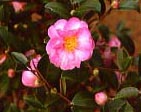 The pastel flowers of fall blooming camellias contrasts with the other signs of fall but they never fail to catch my eye and make my spirit soar. True, there are red flowered cultivars too, and they are beautiful, but the pink and white ones stand out because of the contrast of the flowers with their foliage. And the foliage is gorgeous; I would grow camellias just for their dark green glossy foliage that looks terrific in flower arrangements as well as in the garden. By carefully selecting cultivars you can extend the season of bloom from fall through winter. Unfortunately, theses camellias are only hardy to zone 7 (some to 6) but they are a treasure and well worth growing if you have the climate for them.
The pastel flowers of fall blooming camellias contrasts with the other signs of fall but they never fail to catch my eye and make my spirit soar. True, there are red flowered cultivars too, and they are beautiful, but the pink and white ones stand out because of the contrast of the flowers with their foliage. And the foliage is gorgeous; I would grow camellias just for their dark green glossy foliage that looks terrific in flower arrangements as well as in the garden. By carefully selecting cultivars you can extend the season of bloom from fall through winter. Unfortunately, theses camellias are only hardy to zone 7 (some to 6) but they are a treasure and well worth growing if you have the climate for them.
Type: Evergreen woody shrub.
Outstanding Features: Showy flowers; lustrous, dark green foliage.
Form: Upright, pyramidal to oval shape. Densely branched.
Growth Rate: Moderate.
Bloom: 2-3” wide white, pink to red flowers in fall or winter. Flowers may be single, double, peony or anemone like.
Size: 6-10’ H x 5-7’ W.
Light: Sun to part shade.
Soil: Acidic pH 6-6.5), moist, well-drained soil high in organic matter but can tolerate some drought once established.
Fertilizer: Apply compost, aged manure, or cottonseed meal in early September. Apply an azalea fertilizer in spring.
Hardiness: Zones (some 6) 7 to 9.
Care: Can be sheared immediately after blooming to form a hedge but otherwise let them grow without pruning.
Pests and Diseases: Scale, spider mites, aphids, thrips, cutworms and voles can be a problem.
Propagation: Aerial rooting or cutting taken from new growth.
Selected Cultivars: There are hundreds of cultivars so picking a few is difficult but the following list can give a general idea of what is available in terms of color and form:
White double: Mine-No-Yuki
Pink semi double: Cotton Candy
Red single: Yuletide
Red semi double to double: Shishigashira
Red peony: Wm Lanier Hunt
Cultivars also vary in regard to bloom time so careful selection can ensure blooms throughout the fall and winter.
Comments: Sunscald can be a problem if these camellias are planted in a sunny unprotected site. Buds are sensitive to cold and should be protected by a bed sheet if unseasonable cold snaps occur.
